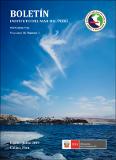Por favor, use este identificador para citar o enlazar este ítem:
https://hdl.handle.net/20.500.12958/3350Registro completo de metadatos
| Campo DC | Valor | Lengua/Idioma |
|---|---|---|
| dc.contributor.author | Velaochaga, Germán | - |
| dc.contributor.author | Xu, Han | - |
| dc.contributor.editor | Instituto del Mar del Perú | - |
| dc.date.accessioned | 2019-09-09T14:38:11Z | - |
| dc.date.available | 2019-09-09T14:38:11Z | - |
| dc.date.issued | 2019 | - |
| dc.identifier.citation | Bol Inst Mar Perú. 34(1) 2019: p.265-276 | es_ES |
| dc.identifier.issn | 03787702 | - |
| dc.identifier.uri | https://hdl.handle.net/20.500.12958/3350 | - |
| dc.description.abstract | Los derrames de petróleo tienen un impacto significativo en el ecosistema marino, la detección remota es una herramienta eficiente para revelar estos eventos con el fin de reducir el daño generado. Se utilizaron imágenes de los satélites ópticos (Landsat-8, Sentinel-2a y NPP) y del radar (Sentinel-1B) para generar la firma espectral, la Temperatura de la Superficie del Mar (TSM) y la razón de bandas. Para el día 15 de febrero del 2017, la firma espectral de los cuerpos de agua en el área del posible derrame se encontró sobre el agua oceánica y la imagen de TSM mostró un aumento de temperatura (>0,4 °C) en dicha área, además el coeficiente “petróleo/ agua” tuvo un valor máximo de 3,407 para la longitud de onda central λ = 0,864, 6 nm, lo cual implica la mayor sensibilidad del canal con respecto a la información de petróleo. Asimismo, al revisar imágenes de los satélites Sentinel-1B y -2A del 3 y 19 de febrero, se observó una pluma que se desprende desde la plataforma activa y se desplaza hacia el suroeste. El objetivo del trabajo es presentar una serie de técnicas para la detección de derrames de petróleo en el mar utilizando las imágenes de satélite, a fin de desarrollar un sistema de monitoreo para las áreas cercanas de las plataformas petroleras en el mar peruano. | es_ES |
| dc.description.abstract | ABSTRACT: Oil spills have a significant impact on the marine ecosystem, remote sensing is an efficient tool to reveal these events in order to reduce the resulting damage. Images from the optical satellites (Landsat-8, Sentinel-2a, and NPP) and radar (Sentinel-1B) were used to generate the spectral signature, the Sea Surface Temperature (SST), and the band ratio. By 15 February 2017, the spectral signature of the water masses in the area of the possible spill was found on the oceanic water and the SST image showed an increase in temperature (> 0.4 °C) in that area. In addition, the “oil/ water” coefficient had a maximum value of 3.407 for the central wavelength λ = 0.864.6 nm, which implies the greater sensitivity of the channel in relation to oil information. Also, when reviewing images from the Sentinel-1B and Sentinel-2A satellites on 3 and 19 February, a plume was observed detaching from the active oil-drilling platform and moving towards the southwest. This work aims to present a series of techniques for the detection of oil spills at sea by using satellite images, in order to develop a monitoring system for the surrounding areas of oil platforms in the Peruvian sea. | - |
| dc.language.iso | spa | es_ES |
| dc.publisher | Instituto del Mar del Perú | es_ES |
| dc.relation.ispartofseries | Boletín IMARPE;34(1), 2019 | - |
| dc.rights | info:eu-repo/semantics/openAccess | es_ES |
| dc.rights.uri | https://creativecommons.org/licenses/by/4.0/ | es_ES |
| dc.source | Instituto del Mar del Perú - IMARPE | es_ES |
| dc.source.uri | Repositorio Digital IMARPE | es_ES |
| dc.subject | Derrames de petróleo | es_ES |
| dc.subject | Ecosistema marino | es_ES |
| dc.subject | Imágenes de los satélites | es_ES |
| dc.subject | Temperatura de la Superficie del Mar (TSM) | es_ES |
| dc.title | Detección de posible derrame de petróleo en el mar peruano frente a Talara usando imágenes satelitales, febrero 2017 | es_ES |
| dc.title.alternative | Detection of a possible oil spill in the Peruvian sea off Talara through satellite images, February 2017 | es_ES |
| dc.type | info:eu-repo/semantics/article | es_ES |
| Aparece en las colecciones: | Boletín 34(1), 2019 | |
Ficheros en este ítem:
| Fichero | Descripción | Tamaño | Formato | |
|---|---|---|---|---|
| Boletin 34(1)-17.pdf | 1,48 MB | Adobe PDF |  Visualizar/Abrir |
Este ítem está sujeto a una licencia Creative Commons Licencia Creative Commons

